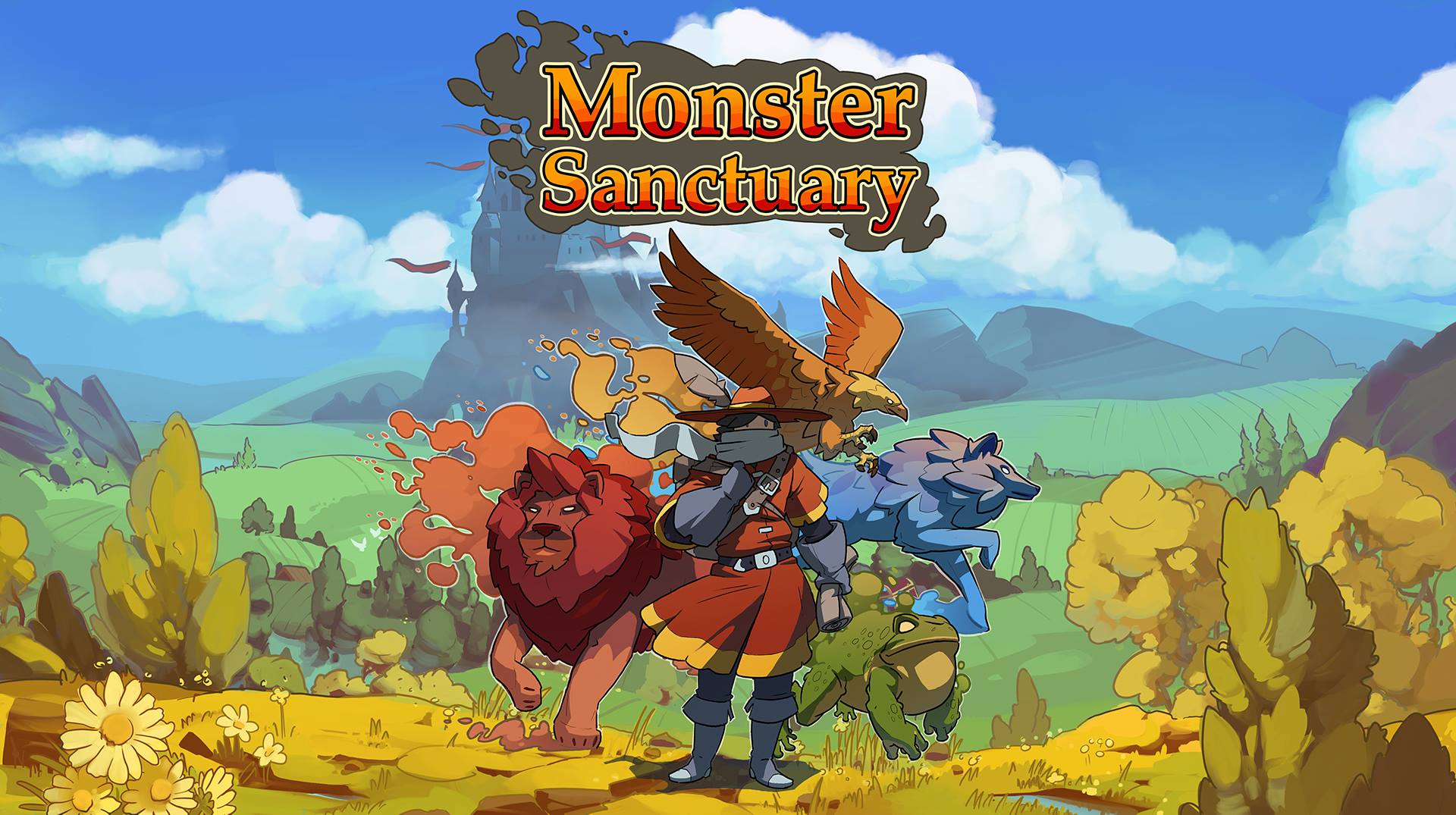My first thought upon opening a chest containing Double Jump Boots was that I could now reach the next platform back in the main chamber of this cave. My second thought, immediately afterward, was that I could finally jump up to the cliff that weird eyeball tiger was hanging out on back at the beginning of the tutorial zone. Maybe, if I kicked its ass hard enough, I could get it to give me an egg.
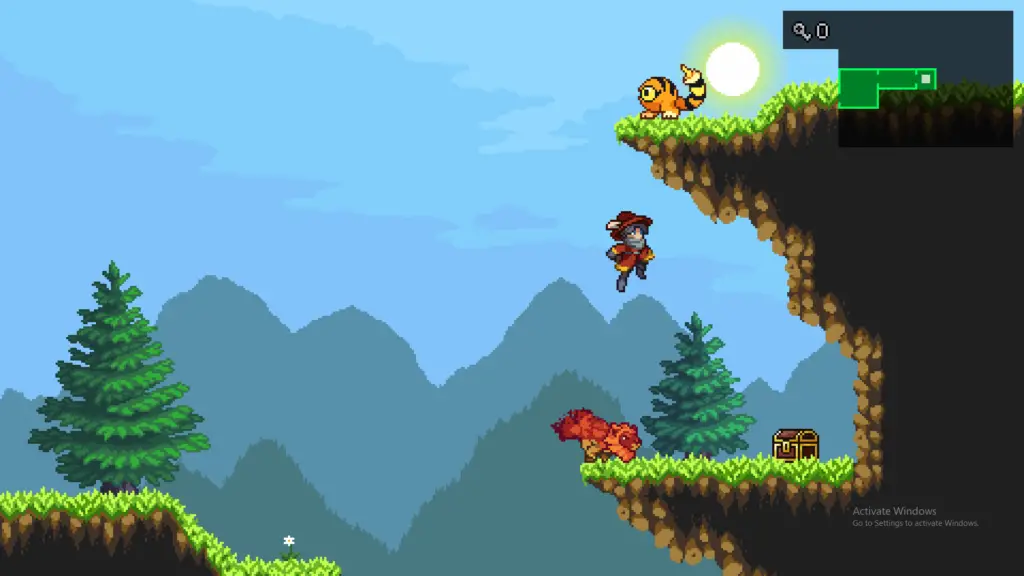
Monster Sanctuary is the game I dreamed of as a child. It’s got monster collecting, there’s platforming, it has Metroidvania-like exploration, and most of all – the combat doesn’t get boring. Through intricate skill trees, clever weakness/defense pairings, three-monster team composition, and a hype-building combo system, Monster Sanctuary builds on core franchises of gaming and improves them through complex but clearly communicated design.
Denis Sinner, the lead developer of Monster Sanctuary, cites Eric Barone’s knockout success Stardew Valley – a PC love-letter to games like Harvest Moon and Rune Factory – as the inspiration for starting development on MS. Much like Stardew Valley, Monster Sanctuary brings an under-represented genre to PC – and sets the bar higher than it has ever been before for games of its kind.
The World
Monster Sanctuary is set in the titular Sanctuary, a kind of magical wildlife preserve overseen by a society of Monster Keepers who tend to the Sanctuary and keep the preserve running smoothly. Wild monsters roam the Sanctuary, and if defeated in battle will often reward a Keeper with an Egg – any monster hatched from an Egg by a Keeper is loyal to that Keeper, and integrates into human society. The Sanctuary itself was founded by four families, and you play as a young Keeper from one of these bloodlines – at the beginning of the game, you’ll choose which Spectral Familiar your bloodline has partnered with, and this monster will become your guide through the adventure.

The story of Monster Sanctuary starts smoothly, with your Familiar introducing you to concepts about the Sanctuary and your duties as a Keeper – the main one being to handle Champion monsters, which are powerful beasts that occasionally crop up around the Sanctuary and disturb the ecosystem. But something is amiss – there have been a bunch of Champion monsters throughout the Sanctuary lately, and no one can quite figure out why. As you explore the different biomes of the Sanctuary and run in to the other Keepers from the founding bloodlines, you’ll uncover a sinister plot – a society of Alchemists using magic from the Old World have infiltrated the barrier, and are using their unknown powers to corrupt the very core of the Sanctuary.
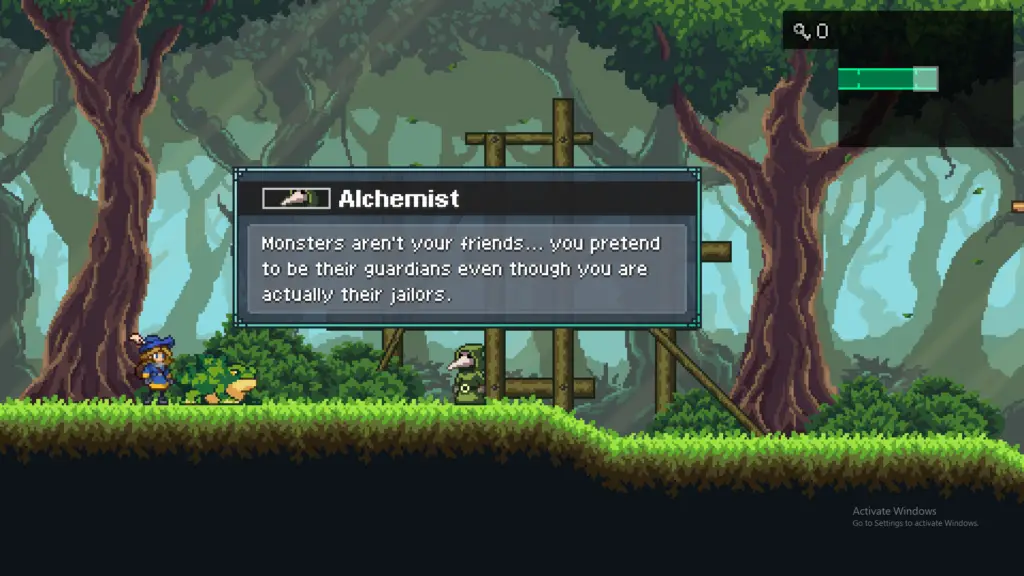
Each zone in Monster Sanctuary is rendered beautifully – the pixel art style across the game is legible, colorful, and has a lot of variety even within zones. Over the course of your adventure you’ll explore damp caves, snowy mountains, fiery workshops, a combined beach/underwater zone, and even an underground sun temple.
Battles in Monster Sanctuary aren’t random – each team of wild monsters is placed in a specific zone around the world, walking around just like your character. If there’s a monster species you’re chasing, you don’t have to waste your time walking through tall grass hoping to get a hit – you can just go find the species you want and fight it. When you run into a monster, combat begins after a white flash – and you’ll notice that your battle screen is the map you were just running around on. Every battle having its own small setpiece makes every fight feel tied to the world, and it makes the world feel so lived-in.
Monster Sanctuary’s world is a 2D platformer, and each monster you hatch has its own ability it can use to help you explore the Sanctuary. Some monsters will help you burn down vines, break hidden walls, or activate elemental orbs – often for the purposes of finding hidden treasure chests throughout the map. Other times, you’ll need a monster with a specific movement ability – like flying, or running really fast. The level design is good about indicating whether you’re able to succeed or not – if a ledge seems too high or a gap too wide, it’s a good sign that you’ll eventually find a monster to help you conquer it.
Muscle and Bone
The mechanics that make Monster Sanctuary tick are simple and brilliant. There’s a lot going on inside MS, so for now I just want to talk about the way Monster Sanctuary handles the star of the show: the monsters.
Monsters in MS each have a set of skill trees, which determine the active and passive abilities they can learn and use. Each member of a species is identical, and there’s no way to teach a monster an ability it doesn’t have in its skill trees. You unlock nodes on the skill trees with skill points, which the monster earns every time it levels up. Stronger abilities are gated at certain level thresholds, which stops you from rushing down one tree and letting the monster’s other capabilities atrophy – but that doesn’t mean you shouldn’t be selective about which nodes you decide to unlock.
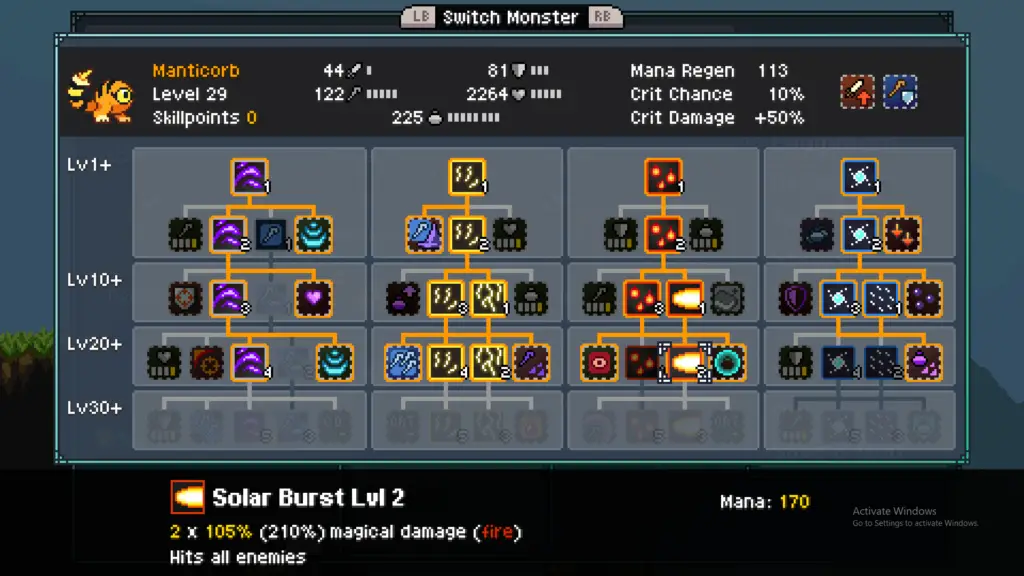
The skill trees inside each monster often have a great deal of interplay across them, which you can only fully exploit by sharing skill points across all of a monster’s different trees. Each skill tree is rooted at some core active ability, either an attack, a healing ability, or a buff. Attacks can be either physical or magical, which are affected by the monster’s attack and magic stats, respectively. Monsters can gain attack and magic points through their skill trees, but the real way they boost their stats is through equipment.
Each monster can equip one weapon and three accessories. The game is very generous with giving you monster items if you’re diligent about accessing treasure chests, which are hidden throughout the world. If you’d rather not look for treasure (you weirdo), you can just buy equipment at the Keeper Stronghold and upgrade it at the blacksmith, using crafting materials you collect from treasure chests and successful monster battles.
If your equipment isn’t quite getting your monster’s stats where you want them, you can also feed your monsters snacks that give them small, semi-temporary stat boosts. A monster can only have three food buffs at a time, so if you decide you’re refocusing a monster’s stats you’ll have to give up some food buffs in exchange for the new ones.
Most of the attacks in Monster Sanctuary have an element associated with them – Earth, Fire, Water, or Air. Each monster also has a resistance to a damage type, and a weakness to a damage type – which isn’t as simple as you think it is. Monsters with a lot of water attacks aren’t always weak to earth damage, and fire-heavy monsters aren’t reliably weak to water. In fact, there’s a few monsters who are weak to elemental damage that they are capable of dealing. This isn’t an oversight – I think it’s a stroke of monster design genius.
Every monster in MS (currently around 80, with 101 at final release) feels truly unique. Based on their skills, monsters fall into fairly clear roles – but it’s up to you to decide how you want those roles to mesh in battle. While some monsters may seem similar in terms of which abilities they have access to, the variety of weakness/resistance pairings keeps you on your toes, swapping monsters out due to their elements… and then finding that if you’re already swapping that monster out, you might as well switch in this monster too because those two have really good synergy, and so on and so forth until you’ve completely swapped over your team.

This is where the passive abilities in the skill tree really come into play. While a lot of monsters have passives that only affect themselves and the way their own active abilities work, most monsters need a friend to achieve their full potential. For example, Wisps and Imoris (little lizards with spears and hats) each have water attacks and can apply the Chill debuff – but the Wisp has a passive that allows Chill to stack more than once on enemies. To complement the Wisp, the Imori has a passive that makes Chill do damage to the monsters afflicted by it – which neither the Wisp or the Imori would be able to maximize on their own.
Monster Sanctuary clearly expects you to go through multiple different team compositions over the course of your adventure – and that’s a good thing. It keeps combat fresh, and keeps your brain working about how different monsters might work together instead of just relying on the monsters you picked up first. MS is full of long-term puzzles like this, from the gradual build-up on skill trees, to the game-spanning accumulation of different kinds of monsters. But MS is built around a short-term puzzle too: the combat.
By Fang and By Claw
If you’ve read my other reviews, I clearly have a thing for turn-based combat that feels like a puzzle, and Monster Sanctuary brings exactly this kind of design by the truckload. MS pulls it off by throwing away a bunch of monster-game convention, taking heaps of ideas from traditional RPG combat, and even using a pungent dash of fighting games. The end product is something that feels resoundingly unique despite its clear influences, and it plays like a dream. At the time of writing this, I’ve put almost 30 hours into MS, and the combat is still exciting. MS scratches the same itch that games like Horizon’s Gate and Card Hunter scratch for me, while still feeling very accessible.
Okay, here’s how it works: battles in MS are 3 vs. 3, and you’ll use your monsters all at the same time before the enemy team acts, until one side is completely defeated. The order in which you use your monsters matters significantly – because, surprise! – each attack isn’t actually just one hit: it’s a series of hits that each do a fraction of some calculated amount of damage. That number of hits then goes into your Combo Counter for the turn, and adds a damage multiplier to any attack that comes next. The game encourages you to use multi-hit abilities early, and then finish your turn with a powerful, low-hit attack. Attacks aren’t the only thing that rack up Combo points either – buffs and heals add stacks, so you’re not discouraged from playing defensively.
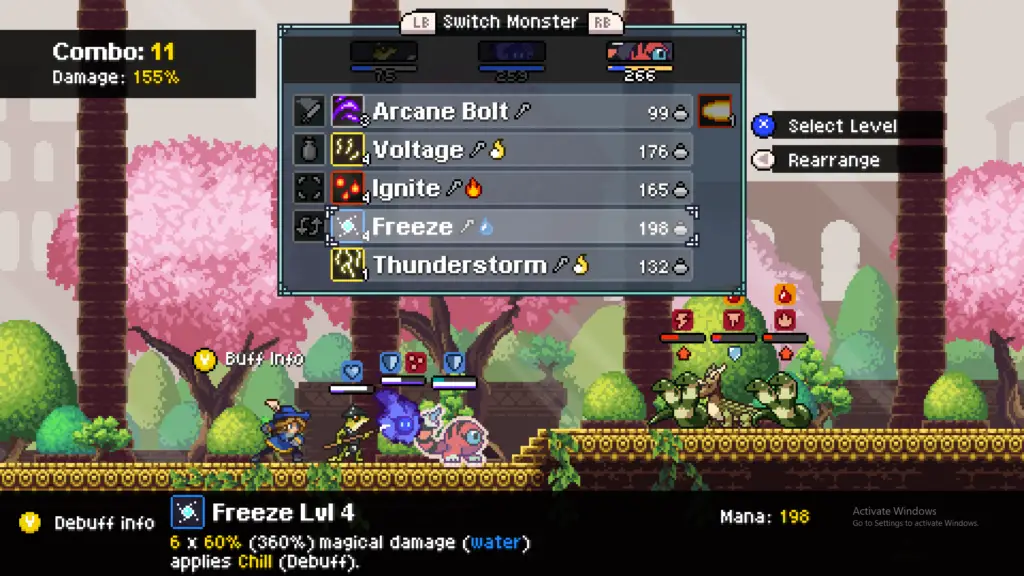
Monster abilities all cost Mana, which regenerates at the beginning of your turn. As you level up your monsters, you’ll unlock higher-level versions of your abilities, which often do more hits at the cost of more Mana. However, if you’re trying to save up mana for future turns but you don’t want to spend your turn using the simple neutral physical attack, you can actually choose to cast the ability at a lower level. Mana is a key resource in battles, and you’ll want to make sure your monsters have equipment that gives them enough mana to use their high-level abilities. As long as you have the mana, you can use an ability as many times as you want – no running back to town to restock on charges in Monster Sanctuary.
The combat feels good right from the start of the game, but the system really cracked open for me when I first encountered a monster that wasn’t just resistant to an element, but all physical damage. I hadn’t even been paying attention to whether attacks were physical or magical! As you progress, you’ll encounter more and more monsters that have non-traditional weaknesses and resistances like this – which makes putting a team together another excellent piece of puzzling.
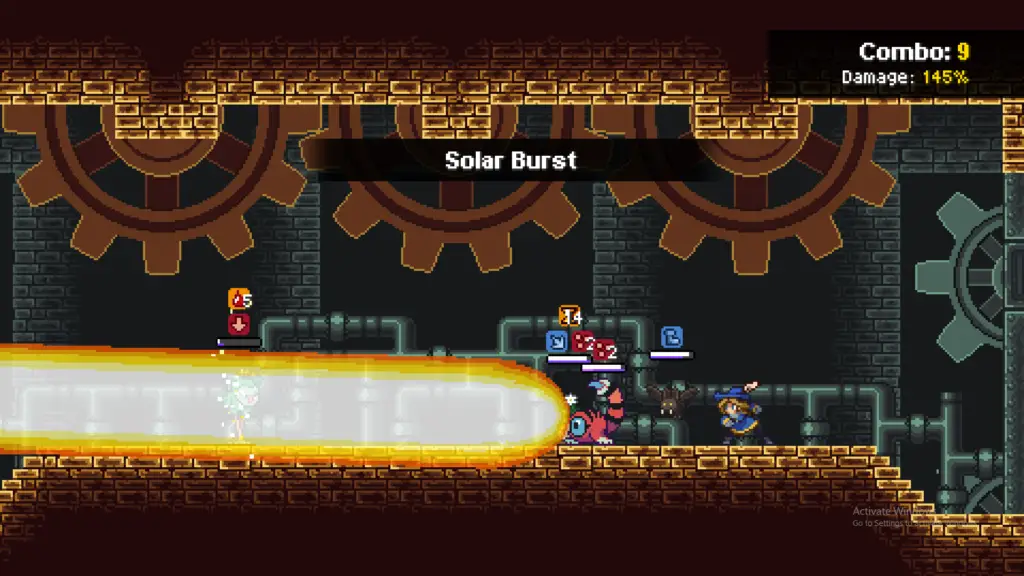
Over the course of the game, you’ll start to fight fewer Champion monsters and more Keeper Battles: encounters with other Keepers who are directing their own team of monsters. Instead of simply having to beat a team of three monsters, you’ll have to knock out all six members of that Keeper’s squad, and the monsters that start on the bench will fill in for a knocked comrade as soon as that spot is open.
Keeper Battles can be incredibly challenging, and they require you to analyze every member of your opponent’s team and pick monsters to counter them effectively. Your opponents will not play fair – there are a few Keeper Battles where your enemy will field a monster that can fully heal itself and a teammate simultaneously, and prioritizing that healer for attacks won’t be enough. Keeper Battles demand that you rethink your team and even design one just for this battle – which is honestly pretty fun. Keeper Battles got me to use monster species I had picked up and then ignored, and it made me really dig into my monster’s skill trees to find the best interplay between my critters.

Nature vs. Nurture
“Wait – if I have to rethink my team for every Keeper Battle, how am I ever going to keep up? Won’t my monsters be really underleveled?” you’re thinking. But fret not – Monster Sanctuary has excellent quality-of-life features. Any time you hatch a monster from an egg, the level of your new monster will be just below that of your highest-level monster – so if you realize that one of your monsters would be perfect for a Keeper Battle but you haven’t used it since it hatched, just go get another egg from that monster species and hatch it to your current level range.
Or, let’s say you’ve got a monster who has all the skill points you could want, but you’ve allocated them poorly. Skill Resetter gems are abundant and cheap, should you decide that you want to re-spec your fighting friends.
The real coup-de-grace here is the fact that you don’t have to give up any of your monsters. While any monsters outside your main team of six won’t accrue experience points, they can still travel with you and be upgraded and swapped in without having to go back to the Stronghold and get them from somewhere. If you want to get rid of a monster permanently, you can send them to the Monster Army, but if you think you might want your pal back you can take them to the Daycare near the Beach instead. Either way, carrying all your monsters around isn’t a problem. The UI for benched monsters is legible, easy to use, and you can even equip them, feed them, and upgrade their skills, just in case.
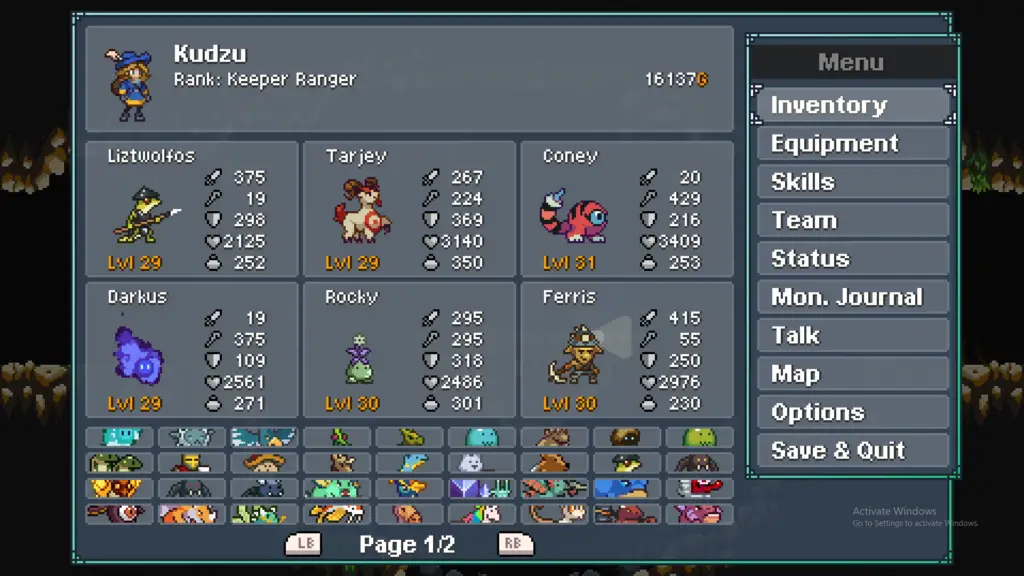
In terms of overall quality-of-life, Monster Sanctuary knocks it out of the park. Want to unequip items from every benched monster? 2 button presses. Upgrading your monster equipment? The items that are currently being used by monsters are pushed to the top of the list, and have a little graphic of which monster is using them. Want to re-battle a Champion monster in case you didn’t get its egg? There’s a room at the Stronghold specifically for doing that. Lost? Open your menu, scroll down to “Talk,” and your Spectral Familiar will remind you about quest threads.
I played Monster Sanctuary with a controller, which the game itself recommends. I found it very easy to use, and I’d double down on the recommendation. I didn’t try using a keyboard and mouse, but it is an option if you don’t have a controller or don’t want to use one.
Cows Come Home
Monster Sanctuary is a masterclass in tight game design, legible and lovely art direction, and engaging world exploration. Each monster is charming and mechanically exciting, and the combat leans in to puzzle thinking in a way that keeps fights fresh throughout the game’s playtime. I expect Monster Sanctuary will be deeply replayable for many years to come, as it will be a joy to meet all the monsters again and try to solve your way through the combat with different teams and strategies.
MS stands tall on the shoulders of its genre’s founders, and like Stardew Valley before it, MS improves and innovates on the genre to create something wholly unique and deeply engaging. If you’ve loved Pokémon in the past but found yourself getting bored, I highly recommend you give Monster Sanctuary a shot and see how good a monster game can be. If you’re a parent of a video game-loving kid, I think MS will be right up your alley – it’s accessible for kids, but it’s got enough mechanical depth to keep an older crowd engaged.
Monster Sanctuary releases on December 8th, 2020 on Steam, Nintendo Switch, Xbox Series X, Xbox One, and Playstation 4.
Disclaimer: The Community Manager for Monster Sanctuary, Conan the Librarian, has previously written reviews for Turn-Based Lovers. We did not collaborate on this article.


